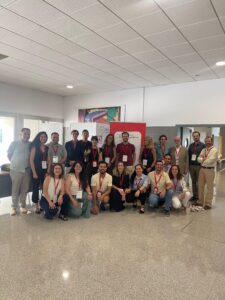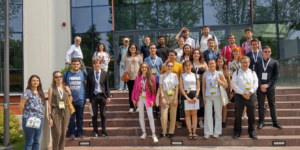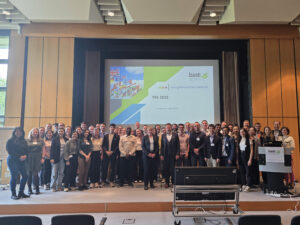TACTICAL URBANISM AND ITS IMPACT ON URBAN MOBILITY.
Mª Eugenia López Lambas
Click here to read the article
TACTICAL URBANISM AND ITS IMPACT ON URBAN MOBILITY. (22-04-2021)
AGENDA_PÚBLICA.
No one doubts today that mobility and urbanism must go hand in hand: you cannot talk about sustainable mobility without talking about the city, which is where the activities that cause these movements are located. To the traditional concept of urbanism (which, in its broadest sense, refers to planning, to the organization of urban space), the tactical adjective was added some years ago as a way of referring to that same organization of public space but on a small scale (less is more, it should be added). It is an urbanism executed from the perspective of the community, based on informal interventions, low cost, fast, very colorful at times, easy to dismantle if necessary and, dare I say, intuitive because they allow to understand instantly, without much reasoning, how beneficial it is for the community to change the use of that space. Volunteer weekends, some painting and folding furniture are at the origin of the transformation of the very emblematic Times Square.
All this allows us to guess what are the advantages offered by these actions: economy, speed and a certain sense of belonging that enhances social and cultural exchange. However, and paradoxically, although tactical urbanism does not contemplate a formal participatory process, judging by the results it has more support from citizens than other (apparently) more participatory actions. It can be said that it is a planning more interactive than participatory, far removed from traditional channels.
We are, in short, facing "short-term actions for long-term changes", according to the phrase coined by Michael Lydon in his famous book, whose ultimate objective, in any case, is to create places where the community meets and socializes, recovering spaces that he considered lost. Emblematic examples of tactical urbanism are found in the most diverse cities in the world: from New York to Santo Domingo, passing through London or Madrid.
Impact
That said, what is its true impact? A recent review of the main actions carried out in the field of tactical urbanism was carried out by Professor Bertolini in 2020; a review in which he asked whether street experiments could really transform urban mobility, limiting motorized traffic in favor of sustainable modes. For this author, answering the question necessarily implied first knowing the impact of each action, taking into account that not all of them have the same nature or scope, neither temporal nor geographical: return parking spaces to the public space ('parklet'), rethink the functionality of an entire street ('open street'), or only one section ('pavement to squares'), to cite some examples, they are the product of tactical urbanism, but of very different execution.
Its conclusions are based on an exhaustive review of the existing literature, from which it extracts a series of criteria that allow it to evaluate the impact of each action in certain aspects. Thus, with regard to parklets (spaces on the streets previously intended for parking and now converted into pedestrian and green areas, sometimes incorporating children's games or free Wi-Fi), he concludes that the impact is positive, although not very large, in terms of social interaction, and somewhat disparate in the economic plane. All in all, it is probably the most widespread type of action and with the most quantifiable results.
Speaking of 'parklets', it should be noted that the pandemic caused by Covid-19 has subverted in many Spanish cities the original meaning of this type of intervention because, although it is true that the space has been returned to pedestrians (so to speak), the reversal has been made through a lucrative business for terraces of bars and restaurants. In this way, the stated objective of this type of space, which is nothing more than to promote active modes of transport (walking and cycling), is not achieved and social interaction is debatable (the groups that sit around a table are already done), while, yes, the increase in economic activity (for some) is undoubted.
Another of the actions included in Bertolini's article are the so-called 'pavement to plazas', within the activity known as repurposing sections of streets. In this case, the example of an ambitious program initiated in New York in 2007 is cited, with the aim that certain streets and squares of the city recover their function as public space and stop facilitating motorized traffic. To this end, sections of some streets and squares were temporarily destined to citizens, while becoming spaces inaccessible to motorized vehicles. The impact of these actions was positively reflected in the use of sustainable modes (walking, cycling, public transport) and in the economy, although it was neutral in terms of traffic flow.
As regards the so-called 'open streets', these are temporary closures to motorized traffic of an entire street to use it as a public space; closures normally associated with some type of organized event (for example, cycling activities). The first performance of this kind took place in Bogotá in 1976 and, from there, the idea quickly spread to other cities, especially from the year 2000. It can therefore be considered the first documented case of tactical urbanism when the concept did not even exist. In terms of results, the impact is mainly on health by promoting physical activity, also improving the quality of life and commercial activity.
Criticism
Perhaps the main criticism that can be made of tactical urbanism is, in general, the lack of evidence on its added value when it comes to provoking a systemic change in urban mobility. Although it is clear that it can contribute to promoting the use of non-motorized modes and reinforcing public space, the temporality of their actions or the events linked to them, to which reference was made above, makes it impossible to assess whether these are interventions that can be assembled and dismantled with unusual speed, without real potential for transformation, or they can cause real changes in mobility habits and even in the lifestyle of citizens. That is, it is not clear whether, in the end, these will not be transitional solutions that will not involve a real transformation of cities, contributing to solving their mobility problems.
Another reproach refers to the place where these actions take place, sometimes emblematic sites, easy to visualize, but not really needed. It would be, then, an instrument of 'gentrification' disguised as a tool for the improvement of the community, but which, in reality, only produces results for the socioeconomically better situated classes, becoming elitist actions that do not represent the interests of the collectivity. Thus, a rebound effect occurs when these well-intentioned improvements end up increasing the value of the property and, consequently, precipitating the gentrification process.
Finally, their very nature (low cost, spontaneity at times) can play against them, causing them to be perceived as temporary, as simple laboratory experiments, to degrade rapidly. In fact, they are often actions that do not prevent motorized traffic completely, but simply interrupt it temporarily or hinder it.
Conclusions
In view of what has been said, it is worth asking whether tactical urbanism can promote the lasting and long-term change that our cities need to achieve the sustainability objectives set by the different agendas. Will it be able to surpass the street level to which it currently (and, for the most part) belongs? Does it have the transformative potential necessary to change the traditional urban structure, overcoming inadequate public policies? Or is it based rather on superficial and short-term actions, partial and overvalued that, in the end, bother more than facilitate mobility in general and pedestrian mobility in particular?
Perhaps all the criticisms made of interventions based on tactical urbanism are not without reason, but, even admitting it, one cannot disdain their undoubted ability to influence the urban form and how we move around the city, even on a small scale. Whether this level goes further will depend on many things; above all, the ability to mix different measures that operate in combination with parklets, open streets and other instruments of the strategy. We know, from experience, that isolated measures do not solve the mobility problems suffered by cities, but sometimes produce an undesirable and unwanted rebound effect. It is therefore necessary to combine this type of urbanism with mobility in the strict sense: promoting public transport, car-sharing programs, bike-sharing, etc. and, in short, actions that allow a true transformation, consistent and in the long term.
Mª Eugenia López-Lambas. Professor of Transport at the School of Roads of the Polytechnic University of Madrid (UPM, Spain).
Deputy Director of the TRANsyT-UPM Transport Research Center.
Coordinator of the Technical Secretariat of the Smart Cities Network.






